We Think About These Roman Empire Desserts Daily

- Oops!Something went wrong.Please try again later.
Travel back in time with us to the days of chariots and togas to indulge your sweet tooth with popular Roman Empire desserts. There's no need for fancy ingredients or cooking methods since these desserts contain everyday items like honey, nuts, wine, eggs, cheeses, flour, and spices. The tantalizing treats of the Roman Empire range from cakes and fried confections to granola-like desserts and custards. They're certainly not boring.
Several of the ancient Roman desserts we know about come from one of the earliest cookbooks in existence, "The Art of Cooking" ("De Re Coquinaria") by the merchant Marcus Gravius Apicius. Tragically, Apicius' quest to find the best ingredients and throw lavish banquets eventually drove him to suicide after he went broke. Another common place we've learned about Roman empire desserts is from Athenaeus, who wrote "The Gastronomers" ("Deipnosophistai") about intellectuals at a banquet talking about food, among other things.
Many of the recipes are vague, leaving a lot open for interpretation from the modern cook. Luckily, the ingredients are simple and readily available today in some form. Of course, the flavor will be different from cooking on modern cooktops versus using ancient methods. Sometimes, we can only make guesses as we fit together puzzle pieces of writers who briefly mention some of these desserts. However, we're sure you're up to the task. So, get ready to start craving and making these ancient Roman desserts.
[Featured image by Pierre Olivier Joseph Coomans via Wikimedia Commons | Cropped and scaled | CC-PD-Mark]
Read more: 12 Popular Ice Cream Brands, Ranked Worst To Best
Cheesecake (Libum And Placenta)
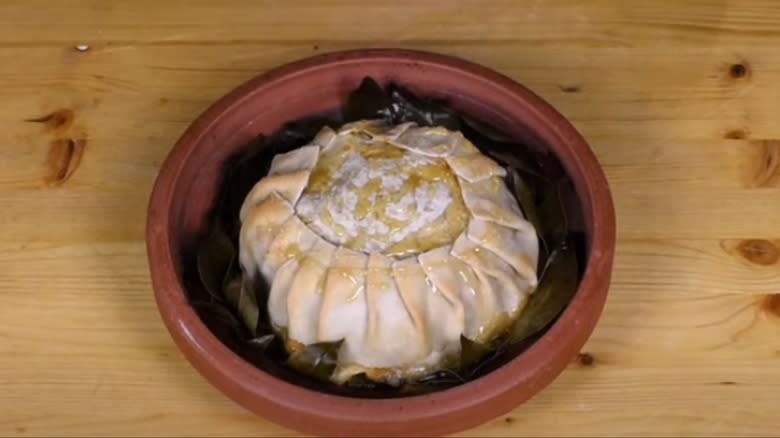
People from the Roman Empire were making cheesecake, so it's older than you probably realized. While ancient Romans didn't have scores of flavors of cheesecake like we do today, this rich dessert still delighted their taste buds.
Statesman Marcus Porcius Cato wrote about cheesecake in his book "On Agriculture" ("De Agri Cultura"). His recipe for cheesecake (libum) calls for 2 pounds of well-crushed cheese, a half to 1 pound of wheat bread flour, and one egg. After mixing these together, you should "shape the bread, placing in on bay laurel leaves. Cook at low heat in the hearth covering with the testum" (per Historical Italian Cooking). A testum was a lidded clay pot the Romans placed on top of their heat source to create a mini oven. Luckily, you can just use a regular oven since this version of cheesecake is reasonably close to the kind of cheesecake we make today.
Cato also included a recipe in his farm book for a layered cheesecake (placenta). In case you were wondering, the word "placenta" in Latin simply means "flat cake." However, Latin anatomists later borrowed the word for the body part (per Online Etymology Dictionary). With all the layers, this version of cheesecake is very different from a modern cheesecake. There's an outer crust as well as several internal layers of pancakes with a honey-cheese filling. Like libum cheesecake, the layered placenta cheesecake is cooked on top of bay laurel leaves using a testum like an oven.
Delian Sweets (Basyniai)
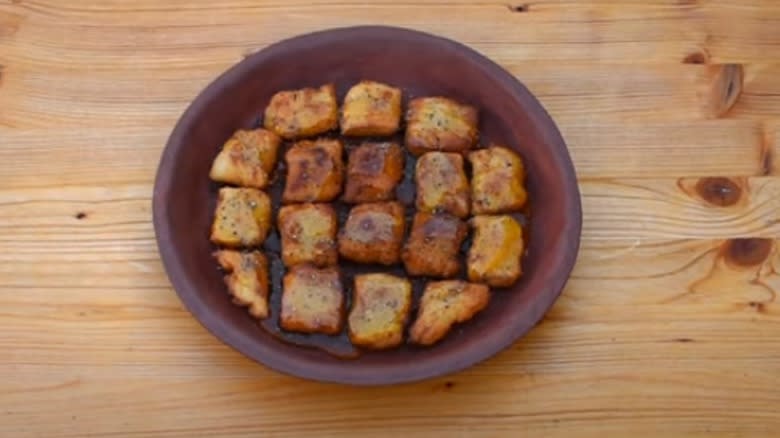
When you make Delian sweets (basyniai), you're making a dessert once thought to be good enough to offer to the gods. In this case, the Greek writer Athenaeus says it was once offered to the goddess Iris on the island of Delos (once known as Hecate's Island). These treats contain flour, honey, and pepper, so the ingredients aren't very complex. The results look a little like honey-covered fried doughnut holes.
Athenaeus doesn't give a lot of instruction about how to make Delian sweets. He simply writes, "It is wheat dough, boiled, with honey and the so-called kokkora (which are a dried fig and three walnuts)" (via The British Museum). It's not clear whether or not the dough ball was served separately from the kokkora. Perhaps you could add the walnut and fig paste on top like a frosting, or maybe it should be mixed into the dough. There's no way to really know.
Apicius goes into more detail, instructing readers to "take durum wheat flour and cook it in hot water so that it forms a very hard paste, then spread it on a plate. When cold cut it up in lozenges, and fry in best oil. Lift out, pour honey over, sprinkle with pepper and serve." This recipe seems much simpler, with pepper being easier to procure year-round than figs. While pepper sounds a little odd for dessert, you'll see it in a few of these recipes from ancient Rome.
Alexandrian Sweets (Itria)
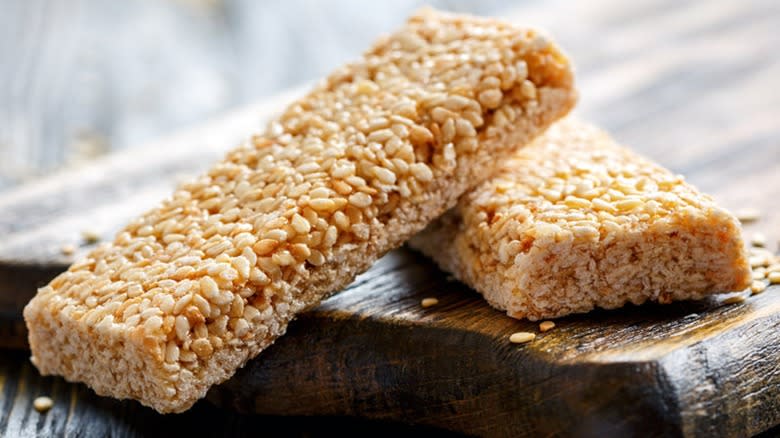
Alexandrian sweets (itria) are a bit mysterious because the hints we have about them are somewhat vague. Several writers mention Alexandrian sweets but only comment on a couple of ingredients or the texture. These sesame seed and honey desserts were likely similar to granola bars.
Athenaeus describes itria as a sesame and honey cake with a delicate texture. Greek poet Anacreon explains the texture as being crisp. Another Greek writer Galen explained that "there are two kinds of itria, the better kind called ryemata [flowed out] and the poorer called lagana [wafer]" (via Hellenic Museum). When the museum staff set about to recreate Alexandrian sweets, they realized that they were making something similar to a modern Greek dessert called sesame bars (pasteli).
You can make Alexandrian sweets by adding sesame seeds (and nuts if you'd like) to hot honey and forming them into balls or bars. The result is somewhat like a seedy and nutty granola bar, which explains the crisp texture Anacreon talked about. Perhaps the difference between the ryemata and the lagana version was that one was soft while the other was hard. At this late date, we can only guess.
Honey Nut Cakes (Gastris)
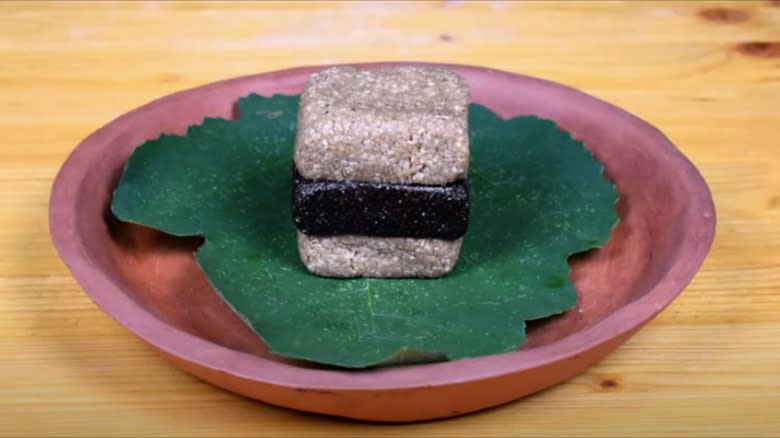
If you haven't noticed yet, honey plays a big role in the desserts of ancient Rome. Without the refined sugar we have available today, it was the most obvious way to sweeten foods. Thus, a lot of the desserts are sticky ones that use honey as a binding agent. Honey nut cakes are especially intriguing because they are a gooey dessert with light-colored layers on the top and bottom and a black layer in the middle. They're uncooked and contain several types of nuts, seeds, and honey.
While Athenaeus didn't always explain the process of creating some of the foods the characters in his book discussed, he did a good job of telling exactly how to make honey nut cakes (gastris). "The Classical Cookbook" reveals Athenaeus' recipe for honey nut cakes. The recipe starts with roasting both sweet and bitter almonds, hazelnuts, and poppy seeds before pounding them into a paste. The dark color comes from the poppy seeds. Then, "kneed with boiled honey, adding plenty of pepper. ... Flatten out into a square. Now pound some white sesame, work with boiled honey, and stretch two lagana, one below and another above, so that the black is in the middle, and divide into shapes."
So, the result looks something like a moist, square seedcake hamburger. How thick or thin you make the layers is entirely up to you.
Pear Patina
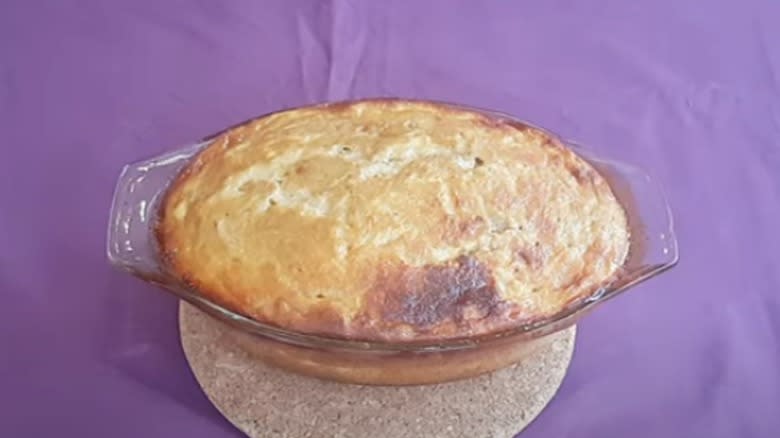
Pear patina is a spiced sweet pear custard with an intriguing flavor combination. It contains cooked pear puree, cumin, pepper, wine, oil, and eggs. Despite not having any thickeners, it still puffs up pretty well.
It's through Apicius that we learn about pear patina. He gives us a list of ingredients and decent instructions for making it. He says that, to make pear patina, you should "stew the pears, clean out the center remove core and seeds crush them with pepper, cumin, honey, raisin wine, broth and a little oil; mix with eggs, make a pie (custard) of this, sprinkle with pepper and serve."
It was likely a fairly sweet dessert since the wine in the recipe is passum, which is made from raisins fermenting in grape juice. With port wine having a very raisin-like flavor, it might be a good modern alternative to passum. Pear patina has a lot of strong flavors to pair with the delicate fruit flavor. To our minds, cumin and pepper are spices for savory dishes. However, with the sweet pears, honey, and raisin wine, this dish was far from being savory.
Stuffed Dates (Dulciaria)
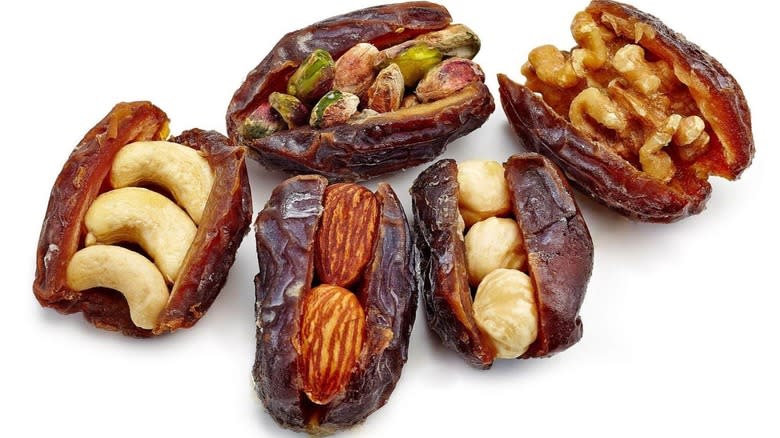
Stuffed dates (dulciaria) look simple enough, but they require a little work. The dates are both stuffed, glazed, and seasoned, turning these ordinary fruits into something special.
Apicius describes stuffed dates thusly: "Dates are stuffed — after the seeds have been removed — with a nut or with nuts and ground pepper, sprinkled with salt on the outside and are candied in honey and served." You can use boiled honey for the outer honey glaze and even pop the honey-covered dates in the oven to candy them further. One trick for stuffed dates is to hide a whole almond as the stuffing. This twist will have unsuspecting guests initially thinking they've chomped down on a pit and then be pleasantly surprised (hopefully) to find a nut instead.
Some people have tried using a more citrusy spice called grains of paradise instead of black pepper for this dish. A Roman author named Pliny the Elder described grains of paradise in his writings as African pepper. However, black pepper was also popular in ancient Rome, so it's your choice which one you use.
Eggs With Honey (Ova Spongia Ex Lacte)
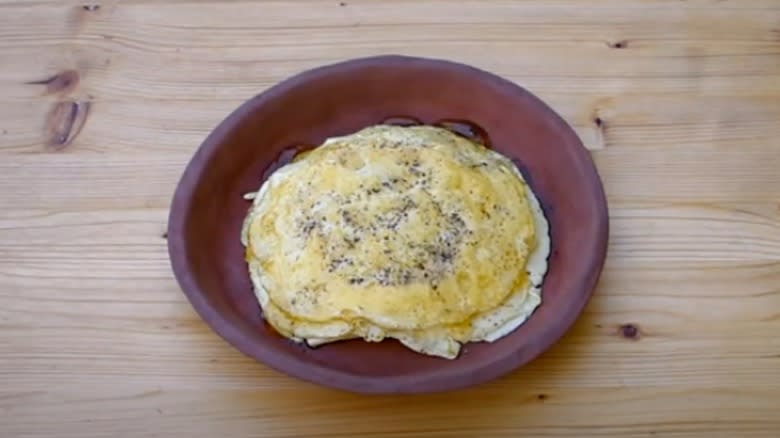
When you think about eggs, you don't usually consider them as being a dessert. However, in the Roman empire, honey was a common ingredient to upgrade eggs and turn them into a dessert. We eat sweet eggy custards, so it's not that far of a jump to a sweet omelet, if you think about it. The Romans called their dessert "spongy eggs made with milk" (ova spongia ex lacte). The ingredients of eggs, milk, oil, honey, and pepper are simple yet unexpected.
Apicius is the source on how to make this sort of sweet omelet souffle. He gives very specific instructions with quantities to ensure the recipe comes out exactly right. To make it, you'll start by mixing together four eggs, the equivalent of half a pint of milk, and an ounce of oil. "In a pan put a little oil, and carefully add the egg preparation, without letting it boil however. Place it in the oven to let it rise and when one side is done, turn it out onto a service platter." You'll then cover the cooked eggs in a drizzle of honey and a sprinkling of pepper.
If you decide to eat more than one, you could stack them like pancakes before drizzling with honey. It might be easier to think of them like pancakes anyway if you're going to eat them sweet.
Cheesecake Bites (Globi)
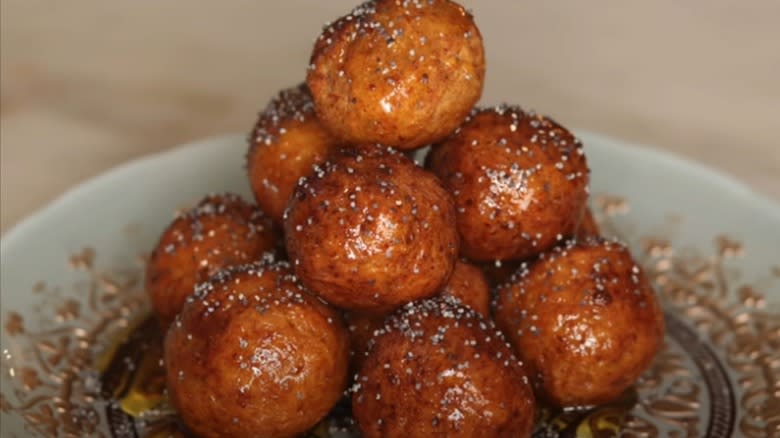
The writer responsible for telling us about ancient Roman cheesecakes, statesman Marcus Porcius Cato, also wrote about a dessert called globi in his book "On Agriculture." Cato's globi dessert is kind of like fried cheesecake bites made from cheese, spelt (a type of wheat that he grinds up without turning it into flour and soaks in water), oil, honey, and poppy seeds. However, they're not cheesecake bites in the same way that they exist today since these treats are fried and have a mix of savory and sweet flavors.
Cato explained how to make these, saying to "mix the same quantity of cheese and [spelt] and shape all the globi you want. Pour fat in a hot copper pot. Cook one or two globi at a time, turning them frequently with two spatulas" (via Historical Italian Cooking). While Cato doesn't tell us what size this dessert should be, we can guess that they're round since the Latin word "globus" is, as you can imagine, a globe-shaped ball. Once you've removed them from the hot oil, you can drizzle honey over them and sprinkle them with poppy seeds.
Looking at the recipe, you'll realize that they're savory fried cheese balls covered in honey. While the bites themselves aren't sweet, the process of coating them with honey turns them into a dessert.
Sweet Spelt
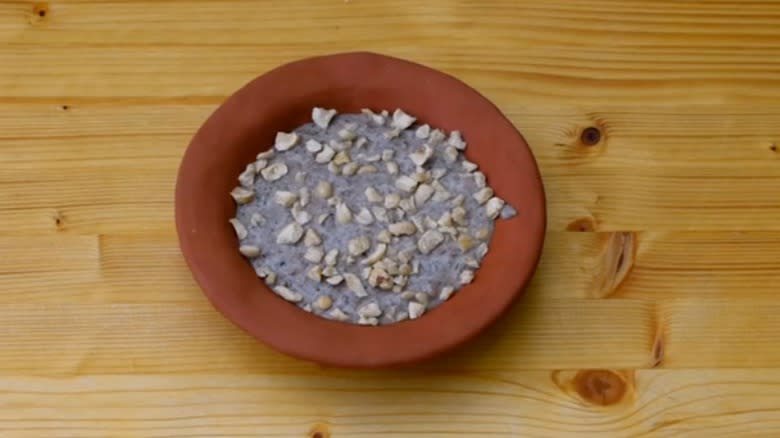
Apicius had a list of several sweet dishes that were easy to make from basic everyday ingredients like porridge that suggest extra items for flavoring. With spelt, honey, two types of wine, and several types of nuts, we think this dish could easily rival modern, trendy grain-based breakfast bowls. However, it's meant to be dessert since it's full of boozy goodness. There are two ways you can eat your sweet spelt: like pudding or as fried cookies.
To make the sweet spelt porridge, you can follow Apicius' easy directions: "In a chafing-dish put honey, pure wine, raisin wine, pine nuts, nuts, cooked spelt, add crushed and toasted hazelnuts and serve."
If you want to try something different and have some leftovers you want to repurpose, Apicius has another suggestion. The first step is to use a "hot water bath or double boiler [to] make a very hard porridge of it. Thereupon spread it out on a pan and when cool cut it into handy pieces like small cookies. Fry these in the best oil." When they're done, you'll cover them in honey and pepper like so many other ancient Roman desserts.
Honey Pudding Or Custard (Tyropatina)
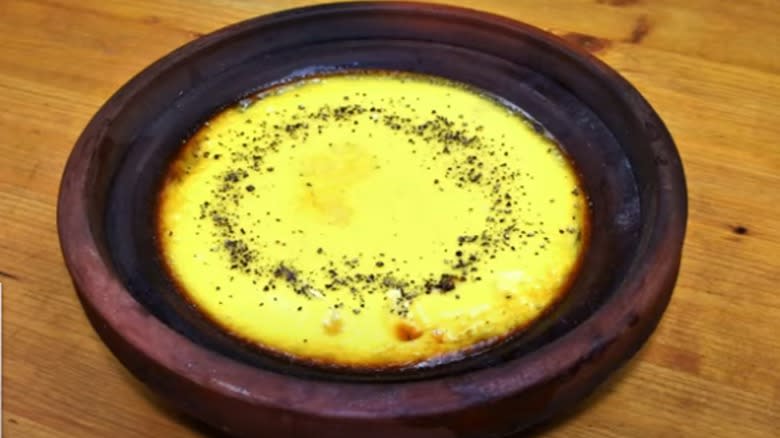
Honey pudding or custard is exactly what it sounds like, despite the misleading Latin name for it. "Tyropatina" comes from the Greek word for cheese (tyros) and the type of cooking pan you'd use to make it (patina). Thankfully, this pudding doesn't actually contain cheese. It only contains milk, honey, eggs, and pepper. When it's done, it ends up looking like a yellow pudding or custard.
Apicius is again the person responsible for preserving this recipe for the world. Unfortunately, his wording is a little vague. He starts by saying to "mix the milk with honey as to make cheese." However, modern cooks have just mixed the ingredients together without thinking about cheese-making at all. He specifies using three eggs for a half pint of milk. "Mix them well with the milk. Pour in a pan and cook at low heat" (via Historical Italian Cooking). Once it's done, you'll sprinkle pepper on top. Since there's no indication of how much honey to add, we guess it's just to your taste specifications.
The recipe doesn't specify boiling or baking as the method. So, you could either try heating it on a stovetop into a pudding or baking it in the oven into a custard.
Sweet Spelt Cakes (Apothermum)
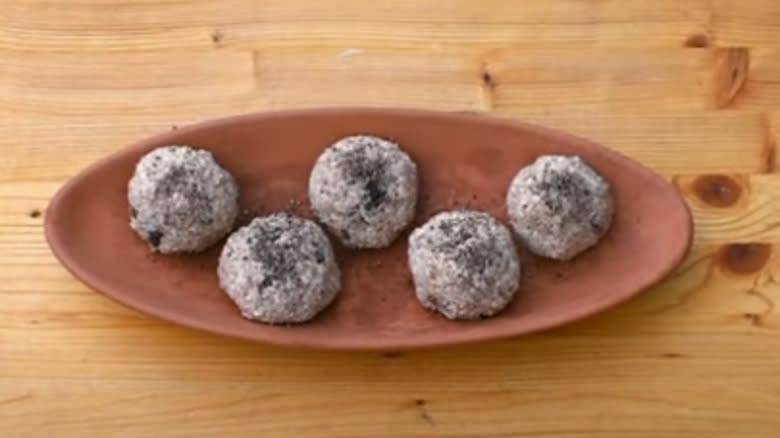
The interesting thing about ancient Rome's sweet spelt cakes is that they're not cooked, which is reflected in their name. Apothermum means "without heat." The ingredients include spelt, pine nuts, almonds, raisins, raisin wine, and black pepper. So, it's kind of the equivalent of cookie dough balls. Despite the name of this dessert, the spelt starts out being boiled, so, it's not technically raw cookie dough and should be perfectly safe to consume.
Here's Apicius' recipe for these white confections: "boiled spelt with pine nuts and peeled almonds, steeped and cleaned in water with clay, in such a way they turn completely white. Mix with raisins and caroenum or raisin wine. Sprinkle ground pepper on top and plate it" (via Historical Italian Cooking). Port is probably a good option for the raisin wine in the recipe. Since it's a sweet wine, it will add sweetness to the dough. Some modern cooks have also tried pulverizing the raisins to add to the sweetness of these sweet little spelt cakes.
Fig Sweets
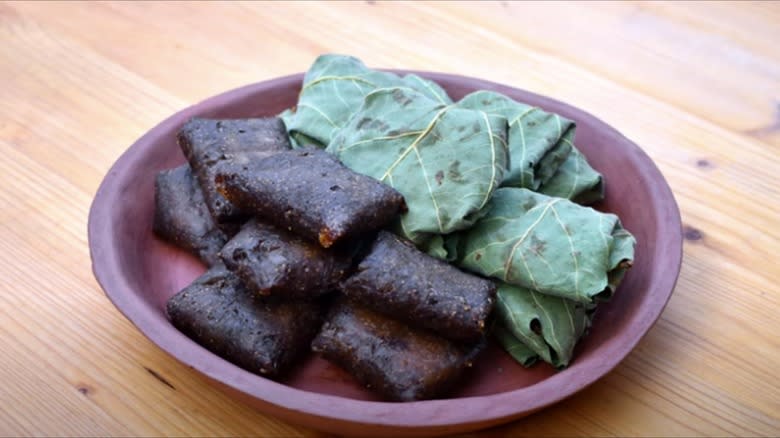
If you've been looking for something to do with extra figs, you might try making this Roman Empire dessert. Fig sweets contain a mixture of dried figs, roasted sesame seeds, and spices formed into cakes and left to dry. These fig sweets sound a little like a spiced precursor to Fig Newtons, only without the cakey part. However, since they're not cooked and they use an unconventional mixing method, they're a little riskier to consume than the other desserts on our list.
This recipe comes from Lucius Junius Moderatus Columella's book "About the Countryside" ("De Re Rustica") about farming (his main profession). The makers of this dish would stomp dried figs, roasted sesame seeds, and spices together with their clean feet like you would stomp grapes. The spices included "Egyptian anise, fennel, and cumin seeds. Once the ingredients are well mixed, they wrap little cakes [made with this paste] in fig leaves ... leaving them to dry" (via Historical Italian Cooking).
Making these could be quite fun if you do it the traditional way with your feet. It's worth noting, though, that using your feet could be a source of bacteria if your feet aren't clean. Since you're supposed to leave this paste to dry in fig leaves for a while, these treats also won't be instantly gratifying.
Read the original article on Mashed.

